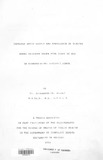| dc.contributor.author | Riedel, Elizabeth | |
| dc.date.accessioned | 2013-05-04T09:27:20Z | |
| dc.date.available | 2013-05-04T09:27:20Z | |
| dc.date.issued | 1995 | |
| dc.identifier.citation | Masters in public health | en |
| dc.identifier.uri | http://erepository.uonbi.ac.ke:8080/xmlui/handle/11295/18957 | |
| dc.description.abstract | This study demonstrates the effect that improved water
supply systems have on water consumption and water use
patterns within households and on the prevalence of scabies
among children under five years of age. A comparison of
households using improved water sources with households
using traditional water sources indicated that access to an
improved water source was not associated with an increase
in water consumption but with changes in hygiene practices.
Children from households with access to improved water
sources were bathed more frequently and changed their
clothes more often.
The prevalence of scabies among children under five years
of age was found to be significantly associated with the
type of water source used by the households. | en |
| dc.description.sponsorship | University of Nairobi | en |
| dc.language.iso | en | en |
| dc.title | Improved water supply and prevalence of scabies among children under five years of age in Tharaka-Nithi district Kenya | en |
| dc.type | Thesis | en |
| dc.description.department | a
Department of Psychiatry, University of Nairobi, ; bDepartment of Mental Health, School of Medicine,
Moi University, Eldoret, Kenya | |
| local.publisher | Department of Community Health, University of Nairobi | en |

